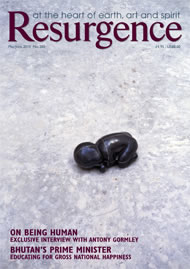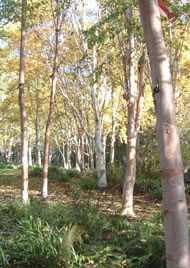Art is often inspired by nature – but then works of art are put in galleries or museums built with unnatural materials and lit by unnatural light.
With increasing ecological awareness, artists are working in nature and want to present their work in natural settings. Henry Moore started this trend by placing some of his sculptures in the landscape. Now, sculptors like Andy Goldsworthy, Chris Drury, David Nash, Peter Randall-Page and others are creating art works of nature, by nature and for nature.
Organisations such as Common Ground have encouraged, supported and promoted this approach which feeds human imagination with nature’s mystery.
June and Kenneth Ashburner facilitate similar sensitivity to nature and art. In the foothills of Dartmoor the Ashburners have created the Mythic Garden where a five-acre woodland has been dedicated to showing sculptures and statues by local artists. This is an extraordinary combination of wild nature and wild art. The woodland holds national collections of birch and alder grown from wild seed. These trees themselves by their nature of unusualness and uncommon beauty make an ideal setting, as background and foreground, for the sculptural work. Thus art and science dance together in full harmony and consort. The running water of ponds lend softness to the hard surfaces of stone and steel.
When we visited the Mythic Garden I asked June and Kenneth to send me their reflections on what they have so delightfully established. Here is their response. – Ed.
The Spell of Trees
We all know how important it is to get beyond the stresses of living and find peace; perhaps in contemplation and prayer, or being out of doors and amidst nature.
In making the Mythic Garden we have been fortunate enough to create, almost by chance and unintentionally, a small area which can contribute to this search for peace. The original aim was a scientific one. I started to compare and contrast various species of birch and alder by growing together the authentic species from around the world. With comparatively little space available, seedlings had to be crowded together in clumps.
To begin with, twiggy three- or four-year-old seedlings stood in the newly harrowed soil of a dry, stony field, surrounded in their first summer by thistles and groundsel. They of course made headway, but even four or five years later there seemed to be no presence or spirit in the garden. However, this began to change. As more years passed, the canopies of the trees met overhead; there were leaf shadows on the summer grass. Shapely stems lit by the winter sun played mysterious tricks of space and shadow at twilight – all unbidden the elements exerted their peculiar power.
The garden is an art form. Its mysterious power goes beyond other art forms. There is movement in the garden; the saying of foliage, for example, changes through time, scents from flowers, aroma from buds, sound from leaves stirred by the wind, and not least an ever-changing perspective. The great reward for people who make gardens is that these elements, endless in variety, are summoned; and if they are helped along or even left alone, they will “get on with it’ and exert their own spell.
It is the power of this spell which we cannot understand; and perhaps it is futile to try to, beyond revering it and recognising that there is something deep in our psyche which responds, and responds in such a positive way that we find healing and space.
An Outdoor Gallery
Having exhibited paintings and craftwork in the gallery I owned for twenty years, it was almost inevitable that we should eventually see the potential of our garden as an outdoor gallery. We first visualised showing work in our farm fields where the views of Dartmoor are stunning. But, as the trees matured in the garden, they offered a much more varied and sympathetic setting. They provided a range of dappled light and shade with changing colours that subtly alters the appearance of the work and allows half-concealed display areas.
We received encouragement from West Country sculptors and Art Colleges. They provided the work for the first exhibition. Since then, we have had work here in a broad range of media; the artists are delighted to show their work away from a formal gallery environment. Most of them seem innately skilled in choosing ideal sites for their exhibits.
Our main objective has been to introduce people to art and trees in an unusual combination. Our true reward has been the visitors’ appreciation in words, letters and poems. What began as a scientific venture has become a magic place with a spiritual quality that seems to spring from the timeless nature of Dartmoor.
For more information on the Mythic Garden, visit: www.mythicgarden.eclipse.co.uk/index.htm








